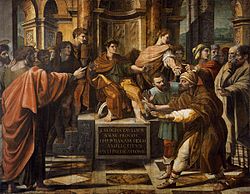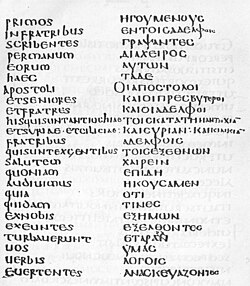|
Acts 13
Acts 13 is the thirteenth chapter of the Acts of the Apostles in the New Testament of the Christian Bible. It records the first missionary journey of Paul and Barnabas to Cyprus and Pisidia. The book containing this chapter is anonymous, but early Christian tradition uniformly affirmed that Luke composed this book as well as the Gospel of Luke.[1] From this point onwards, except for the Council held in Jerusalem (Acts 15), Luke's narrative focusses on Paul, his ministry, and the events of his life.[2] TextThe original text was written in Koine Greek. This chapter is divided into 52 verses. Textual witnessesSome early manuscripts containing the text of this chapter are:
Old Testament Citations Appearing in the Relevant New Testament PassagesThe apostle Paul's "potted resume of Israel's history" [3] in this chapter includes a number of Old Testament references:
New Testament references
LocationsThis chapter mentions the following places (in order of appearance):
TimelineThe first missionary journey of Paul and Barnabas took place about AD 47–48.[7] The church in Antioch (13:1–3) This section opens the account of Paul's first missionary journey (Acts 13:1-14:28) which starts with a deliberate and prayerful step of the church in Antioch, a young congregation established by those who had been scattered from persecution in Jerusalem (Acts 11:20–26) and has grown into an active missionary church.[3] Paul's mission was not his own initiative, but was undertaken at the command of the Holy Spirit (verses 2, 4), with the framework of prayer and fasting forming an inclusio at the end of this first journey (Acts 14:26).[3] Verse 1
This Lucius of Cyrene is thought to be the same person as mentioned in Romans 16:21, or the same as Luke, the writer of the Gospel of Luke and the Acts of the Apostles.[9] Heinrich Meyer observes that:
Verse 2
Verse 3
This ritual of laying on hands relates to the two apostles being commissioned for a specific task: it is not an ordination.[3] Journey from Antioch to Cyprus (13:4–5)The first main destination of the missionary journey is the island of Cyprus, Barnabas' home area (Acts 4:36). There were already believers who scattered due to the persecution in Jerusalem (Acts 11:19), but Barnabas and Saul came on a mission ('sent out by the Holy Spirit', verse 4) to visit formal meeting-places of Jewish communities they pass through (verse 5) to preach the gospel.[3] Verse 4
The governor and the guru (13:6–12) The account of Saul/Paul displaying the supernatural power of the Holy Spirit (verse 9) that led a proconsul into faith (verse 12) parallels Simon Peter's encounters with Simon Magus (Acts 8:14–24), and with Ananias and Sapphira (Acts 5:1–11). Paul sharply denounced Elymas using a prophetic language (verses 10–11) that resulted in the latter's blindness using words echoing Paul's own experience in Acts 9:8–9.[3] Verse 6
It is noted from his failure to recognize the truth of gospel (verse 8) that Elymas is a 'false prophet', using the term magus (verses 6, 8), which is always in negative sense in the book of Acts (Acts 8:5—13).[3] Verse 7
The correct Greek title (anthupatos, proconsul) is used for a governor of a senatorial province. A 'Sergius Paulus' is mentioned in a Roman inscription as a holder of an office in Rome under Claudius (at about the same period)[3] and his family also seems to have a tie to Pisidia.[16] Verse 9
The change of name from Saul (a Hebrew name) to Paul (Latin name; verse 9) is appropriate as he moved deeper into "Gentile territory", and very common for diaspora Jews to have Greek or Latin names alongside their Hebrew names.[3] Verse 12
Luke presents Sergius Paulus as the first Gentile ruler to believe the gospel. Unlike Cornelius (Acts 10:2), there is no evidence that Sergius attended the temple or was a God-fearer. This pagan government official was amazed at the power of God and believed the truth.[19] Journey from Cyprus to Pisidia (13:13-52)It is customary for Paul to start his mission by visiting the local synagogue (verse 14). Paul's sermon in a synagogue of Antioch in Pisidia (13:16—41) serves as the centerpiece of a long and tightly constructed travel-and-mission account, moving into new places (13:13-14, 51; 14:6-7), then successively going back retracing each stage of the journey (14:21, 24–26).[3] All the sites visited by Paul on this journey eventually fall within the territory of the Roman province of Galatia in the first century,[20] so it could be assumed that 'these are the churches Paul addresses in the Epistle to the Galatians'.[3] Verse 13
This John, also mentioned in verse 5, was John Mark, the nephew of Barnabas (Acts 12:25). Whatever the trouble was between Paul and John Mark, it was enough for Paul not to want John Mark to accompany him on a later journey, which caused a rift between Paul and Barnabas (Acts 15:36–39). John Mark would prove faithful later in Paul's ministry (see 2 Timothy 4:11).[19]  Verse 33
Citing Psalm 2:7, which is also quoted and used for exposition in Hebrews 1:5; 5:5.[6] Verse 34
Citing Isaiah 55:3 See alsoReferences
Sources
External links
|
||||||||||||||

